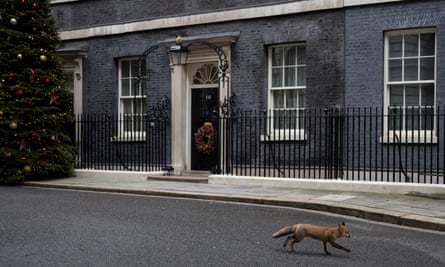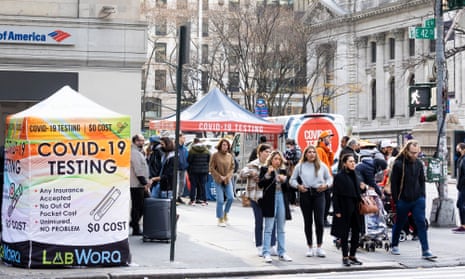Monday
“How are things over there? It’s mad over here.” Until recently that line, delivered by people in the UK to people in the US, gave rise to some smugness among the Americans. During late summer and autumn, the pendulum of who was having a better pandemic had swung firmly towards those in the UK. Enviously, we in New York looked across the Atlantic to British kids sitting unmasked at school, at indoor playdates and parties, and at the conviction, voiced by many in Britain, that everything was more or less back to normal. Now you all seem to have Covid and Christmas is cancelled. No one here is talking about cancelling the holidays.
Or at least, they weren’t. While infection rates in Britain hit all-time highs this week, the US in general, and New York in particular, are sufficiently behind the UK’s Omicron curve to preserve the Christmas period from the likelihood of shutdowns. This week, Omicron crept up to an estimated 13% of new cases in New York and New Jersey, but the positivity rate remained lower than in Britain.
The first sign that things were changing here was last weekend. In the city, long lines for boosters appeared outside the mobile vaccine trucks. There’s one parked on the south-west corner of Central Park, outside a Christmas market popular with visitors and the queue went all the way down the block. By the beginning of this week, office parties in midtown were starting to be cancelled. A trickle of emails came in calling off events I hadn’t been intending to go to in the first place, on account of continuing problems with desocialisation. Broadway, latterly operating at full capacity, started shutting down shows.
By midweek, the rate of positivity across New York state had surged by 40% in one day. And still the vibe in the city remains cheerful. In the eyes of most New Yorkers, our adherence to the rules has been sensibly cautious; by UK standards, it has been histrionic. New York’s instinctive catastrophist outlook at least forestalls disappointment. The advantage of never quite having unclenched, is that even as the numbers shoot up, not much in the way of adjustment is required.
Tuesday
My kids know the story of Hanukkah from school but they wouldn’t know the nativity if it stood up in their soup. I can’t understand how this came about; American public schools are supposed to be stripped of all religion and every December, there’s low-level tension in New York about whether the Christians are sneaking Christmas into schools via the backdoor, that is through crafty pictures of Santa to colour in, in art.
I’m not fussed about who wins that particular fight. Ideally, however, I would like someone else to explain the miracle of Jesus to my kids, just so they have it for reference. No one does, however, so needs must.
“What are we celebrating on Christmas?” I ask them.
“God’s birthday,” says one, and I’m taken aback.
“That’s right! Actually Jesus’s birthday, but he’s God’s son and ... our Lord, so technically it’s the same thing.” We pause to digest this. Then I have a crack at Mary and Joseph and the flight to Bethlehem, grope to remember what happened with Herod and the census, overlook the Three Wise Men and have to go back for them, and do a bad job with the immaculate conception. “Did God plant the seed?” says a child, confirming that I’ve leaned too hard on plant analogies. “Something like that, anyway it was a miracle, we don’t need to dwell on the details.”

Wednesday
The real holy trinity, Carrie, Charlotte and Miranda – light of one fallen angel – are brunching in the bar at the Whitney, downtown. I was never head-over-heels with the original Sex and the City. When I first arrived in New York, I watched a million reruns and found the show cheerful and soothing. I also found it infused, here and there, with the animating force of so much of the fashion industry, that combination of fetishisation and contempt.
The reboot, And Just Like That, takes this tone to absurd extremes. It’s not merely that the three women appear to have woken collectively from a coma they went into in 1973. The rendition of the city itself is bizarre. In this version, New York is a place in which straight people are prudes, non-straight people talk exclusively about sex and smoke weed in elevators, and fiftysomething women haven’t heard of podcasts. Carrie and Big appear to live opposite the News Corp building in a part of town most pigeons would hesitate to occupy. Miranda’s grey hair is a topic of conversation but no one mentions what Charlotte’s done to her face. Carrie has, apparently, never said the word “masturbation” out loud. Miranda is relearning how to talk.
It’s dumb, and infantilising, and more than that seems actively to despise its own characters. The actors are so familiar that some of the old warmth still shines through, but Michael Patrick King seems to be apologising for these women who had the temerity, 15 years ago, to have lunch and talk about their lives. As a self-contained world, the original Sex and the City was no more closed off than Breaking Bad, or Succession for that matter, but of course, as Lena Dunham discovered a decade later, shows led by women are held to different standards.
There is one, touching Norman Maine moment in the first episode, in which Chris Noth stops Carrie on her way out the door. “I’m just looking at you,” he says, a moment I found genuinely touching, before the conversation around Noth changed. Incidentally, Big’s character alone is permitted to be rakish and chill and as devil-may-care as he ever was, suffering no need to apologise or reform. Wonder why.
Thursday
Enough has been said about the profile of Jeremy Strong in the New Yorker to confirm that, after years of puffery towards actors in the press, no one knows what a real hatchet job is any more. Strong sounds like a lovely man who might benefit from watching Ian McKellen explaining, to Ricky Gervais in that episode of Extras, how he acts. (“I imagined what it would be like to be a wizard, and then I pretended, and acted, in that way, on the day. And how did I know what to say? The words were written down for me in a script.”). Anyway, as anyone who is paying attention knows, the real virtuoso of that show is Matthew Macfadyen.
Friday
Some good news at last. If you have been following the story of the Fox News Christmas tree, cruelly set alight last week in a literal enaction of the War on Christmas, you’ll be happy to know the cable news network has found a replacement. Last week, Fox ran rolling news on the unfolding tree fire as if it were rockets over Falluja not a burning fir on Sixth Avenue. Now, a new tree stands proudly outside the News Corp building, on what hacks of insufficient seniority to score an invite to the tree lighting refer to as Forecourt of the Damned. Across the street, Carrie must’ve had a perfect view.


